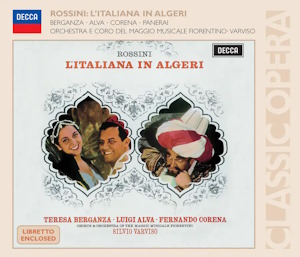
Gioachino Rossini (1792-1868)
L’italiana in Algeri (1813)
Mustafà – Fernando Corena (bass)
Lindoro – Luigi Alva (tenor)
Isabella – Teresa Berganza (mezzo)
Taddeo – Rolando Panerai (baritone)
Elvira – Giuliana Tavolacini (soprano)
Zulma – Miti Truccata Pace (mezzo)
Haly – Paolo Montarsolo (bass)
Chorus and orchestra of the Maggio Musicale Fiorentino/Silvio Varviso
rec. 1963, Teatro della Pergola, Florence
Reviewed as download in lossless FLAC format
Decca 4758275 [129]
This recording was the first attempt to capture L’italiana in Algeri in stereo. Decca engineers usually spent their summers in Rome at the Accademia di Santa Cecilia, however, during the summer of 1963, when this set was made the Roman venue was undergoing a massive renovation. This required that Decca had to relocate to Florence’s Teatro della Pergola, where they recorded this opera, and La Cenerentola immediately afterwards. Decca had been achieving marvelous results recording operas in Rome (most of their complete operas featuring Renata Tebaldi had been made there). Decca had made some previous recordings in Florence prior to this one but the Florentine venue generally produced a less atmospheric sound than the one in Rome. One could argue that for Rossini operas this was beneficial because they don’t register as well if the sound is too cavernous. In any case, the following summer Decca returned to Rome for its opera activities.
The star attraction of this set was Spanish mezzo Teresa Berganza. With her delightful Mediterranean sound she would, on paper at least, seem to make an ideal Isabella. The coloratura demands certainly hold no terrors for her, every roulade and trill is accomplished with skill and vocal allure. Isabella is a character that balances hypnotic charm with a fiery nature, and the ability to dominate the men who succumb to her. Berganza has all of the charm but she lacks the fire that one finds in the portrayals of Marilyn Horne, Agnes Baltsa, and Jennifer Larmore’s recordings.
Mustafà, the Bey of Algiers is another character that balances two opposing natures. In this case the comic fool with a hint of a threatening nature simmering just underneath the surface. Swiss Bass Fernado Corena has the comic side down pat but he is less good at conveying the dangerous side of the Algerian ruler. Vocally he has a strong, attractive bass sound, but he can only sketch in the coloratura passages in a lugubrious fashion. He is excellent in negotiating the rapid patter sections.
Luigi Alva shows a breezy charm as the Italian slave Lindoro. His light tenor has champagne-like colours which turn a bit too dry sounding whenever he has to rise to a top B and beyond. At times his coloratura is a little sketchy as well, certainly he is outclassed by Francisco Araiza and Lawrence Brownlee on later recordings. Alva and Corena are captivating together in the Act one duet.
Rolando Panerai’s dramatically weighted baritone has a deeply Italianate sound which makes his Taddeo a more viable character, one that is to be reckoned with rather than the usual booby he is presented as. When Panerai joins Alva and Corena in the Pappataci trio, magic ensues in one of the comic highlights of the score. Giuliana Tavolacini’s Elvira is affected by a fluttery sound which invades her otherwise attractive soprano. Paolo Montarsolo who was a noted Mustafà is here given the more anonymous role of Haly, which he sings cleanly and crisply.
Silvio Varviso is conducting the older version of L’italiana in Algeri, before Azio Corghi ‘s critical edition restored Rossini’s orchestration to what the composer intended. The flutes doubling the bassoons during the overture may sound odd to those who only know the overture in its restored guise. Varviso tends toward more relaxed tempi, which is not necessarily a bad thing in Rossini. Too often have I had to endure hyper-driven performances of this work which do not allow the music to breathe naturally and increase the challenge to the singers. Varviso’s overture bubbles along with gusto, and elsewhere his tempi are always considerate towards the singers. At less driven speeds some details emerge more clearly such as the laughter of the strings when Isabella and Mustafà sing “O, che muso, che figura”. Varviso also captures the irony of the chorus of Eunuchs, with their booming macho voices. In the famous first act finale he paces it in a wide comedic arc grows from the initial confusion to the chaos at the end. The Florence forces are efficient but are nothing outstanding in terms of ensemble. This is not the finest recording of L’italiana in Algeri but there is enough of substance here to spend a couple of very enjoyable hours with Varviso and his company. There is no digital booklet with this download.
Mike Parr
Help us financially by purchasing from



















